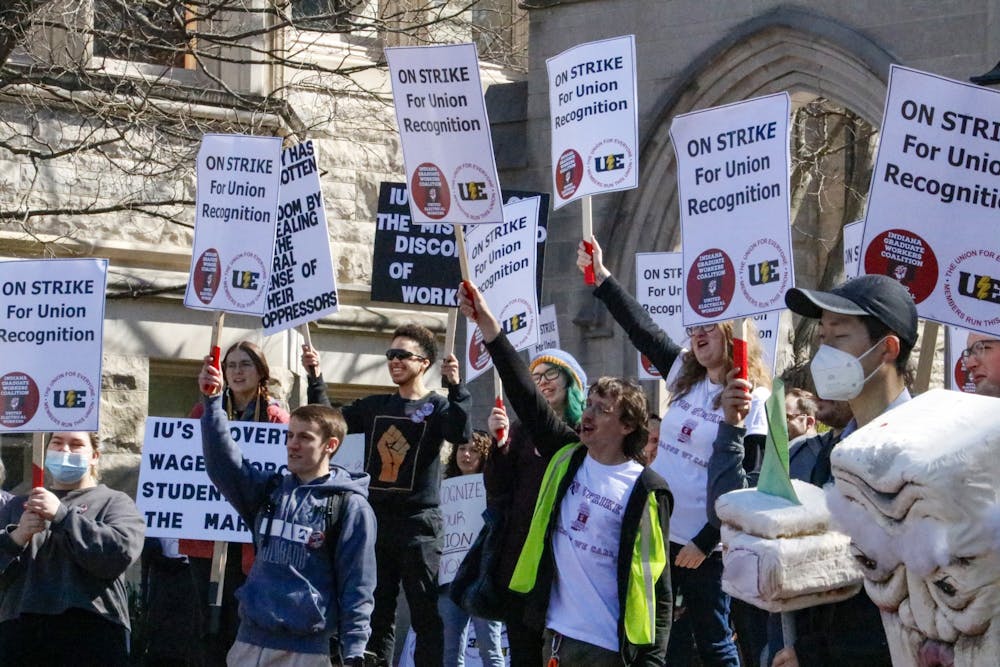The Indiana Graduate Workers Coalition-United Electrical Workers began its strike to gain union recognition from the IU administration Wednesday, April 13.
However, severe weather conditions postponed picketing efforts until Thursday, April 14.
After more than three years of battling with IU administration for higher pay and lower fees, some graduate student workers are refusing to teach classes, grade assignments and perform other tasks until IGWC-UE votes to end the strike.
The strike comes as a last resort after the university rejected IGWC-UE’s request for an election to certify their status as a union in February.
By 10 a.m. April 14, shouts, cheers, boos and songs echoed from all corners of campus.
Demonstrators surrounded the Sample Gates, Global and International Studies Building, Chemistry Building and Wendell W. Wright Education Building. Their presence could not be ignored — from bullhorns to kazoos the picketers made noise.
Related: [Everything you need to know about the IU graduate worker strike]
Their most popular chant made one thing abundantly clear: the IU graduate student workers want a union. And they want it now.
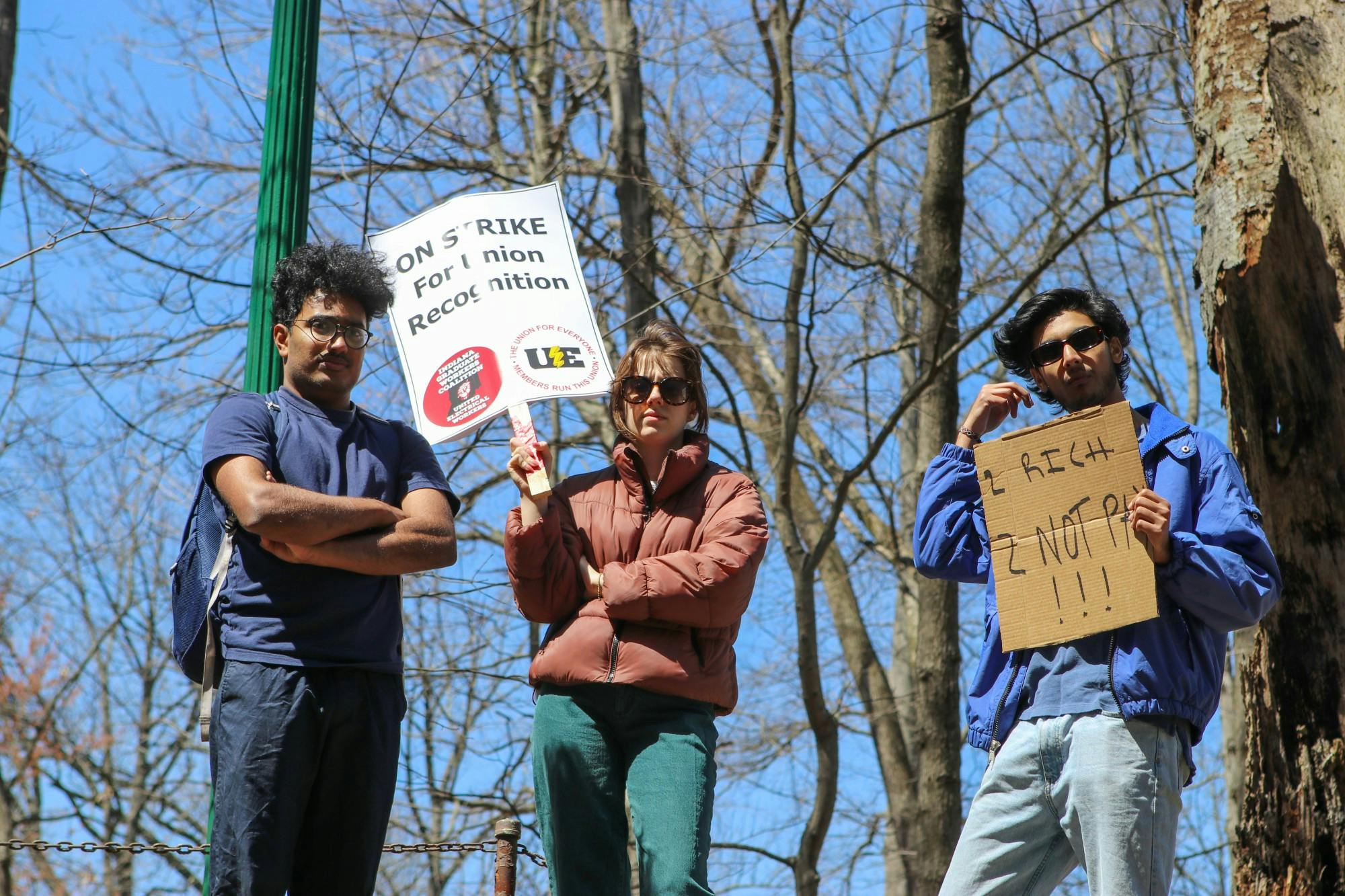
At 9:30 a.m., Kirkwood Avenue was quiet.
Picket signs were unpacked from white trash bags that came hand-delivered on a bike that morning. As the signs were collected, leaning up against Sample Gates by the dozen, students started to arrive.
Little by little, students huddled together in front of the IU landmark until a crowd of around 80 people stood in protest. They handed one another signs, some fitted with red tape around the handle to make it comfortable to hold for multiple hours at a time.
Ph.D. candidate Pat Wall jogged around the crowd, trying to direct them to give room for others walking by. He had planned for this moment and it was now starting to unfold all around the Bloomington campus.
By 10 a.m., Bloomington Mayor John Hamilton had arrived. He walked around to the students, greeting them individually. Later, he made his way to the front of the crowd to share a few words.
“I know you’re here because you’re committed to making this a better place, together,” Hamilton said.
Behind him, a campus bus was leaving its stop, its driver sounding the horn three times as a nod to the picketers.
The horns from the street kept coming, one after the other.
“That feels good doesn’t it?” Hamilton said to the crowd. “I’ve done it as a candidate when you’re out there with the signs and they honk; it’s nice. There are a lot of people who care for you and what you’re doing.”
Hamilton thanked the students for engaging in organized labor and was met with cheers. Wall then took over once more, starting another chant — one of many for the day.
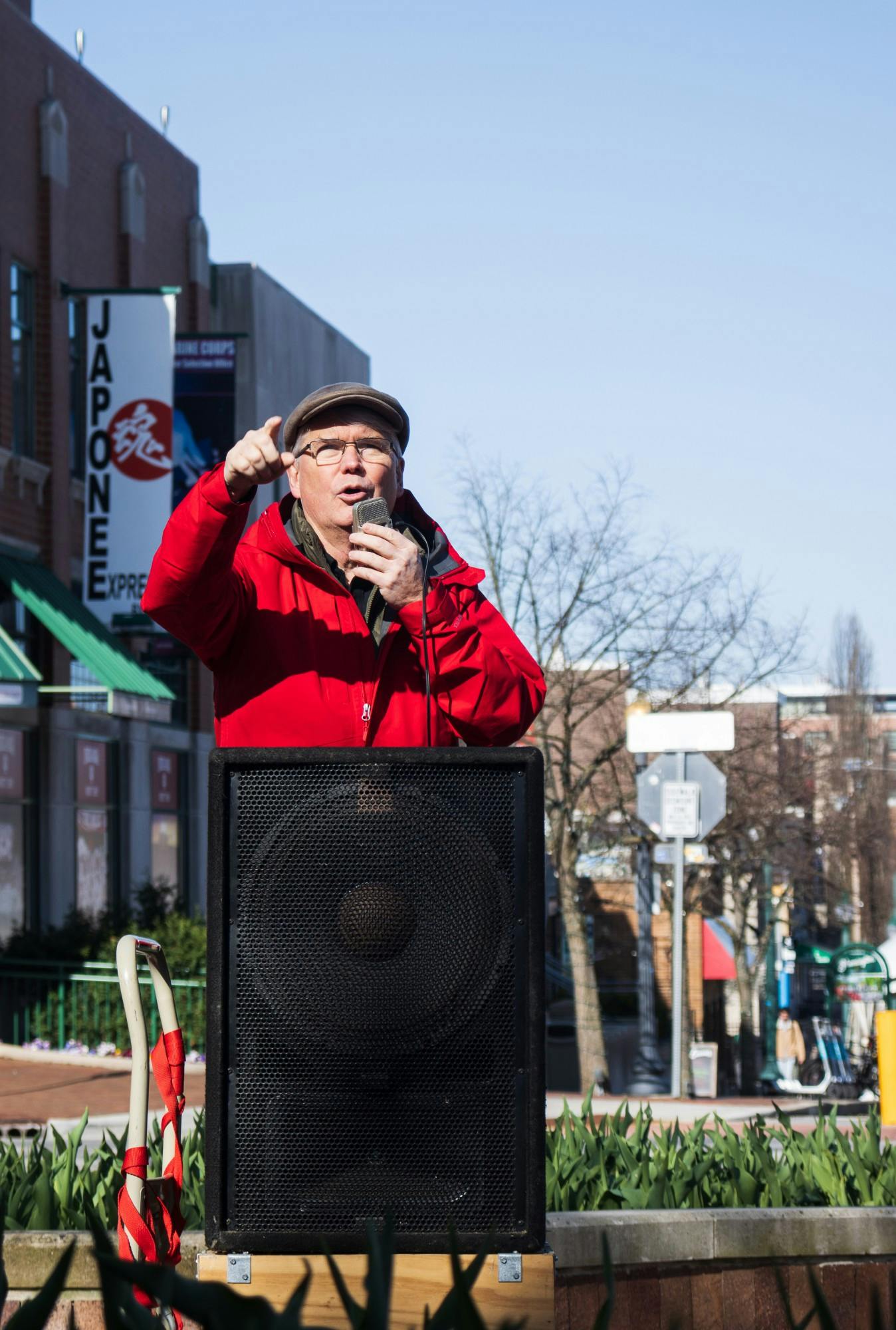
At 9:55 a.m. four graduate workers stood outside the IU Chemistry Building on the second day of the strike, waiting for the picket to begin.
They didn’t know each other before this morning — they don’t have much in common. They represented vastly different academic departments: physics, gender studies, Germanic studies and history. But now they’re here, united by their shared goal: a union.
Related: [As graduate workers prepare for strike, provost lays out potential consequences]
Bags full of white picket signs that read “ON STRIKE For Union Recognition” sat in the corner. As more and more graduate workers trickled in, the bags began to empty. The four who arrived early handed out noise makers. The sound of kazoos and cowbells filled the air, followed by laughter and chants.
“What do we want?” Rory Barron, a graduate worker in the gender studies department, shouted.
“A union!”
“When do we want it?”
“Now!”
The resounding responses echoed off the buildings, and the chants grew louder as more people joined the picket line. By 10 a.m., there were two dozen picketers. Fifteen minutes later, there were more than 50.
Not all chants go as smoothly. “Hey hey, ho ho, graduate workers got no dough” took a couple of tries.
But they laughed it off, and by the second try, they found their rhythm and shouted as one united voice.

By 10:15, dozens of picketers crowded the edges of the sidewalk at the front entrance of the School of Education. Young and old shouted together: a man raised a pro-union sign while, a few protesters behind him, two girls trailed behind their father.
The chilly morning hadn’t kept them away. The picketers formed a circle at the entrance, walking faster and shouting louder, as they used stiff fingers to unfold papers with protest chants printed on them. Led by a graduate organizer, they raised their signs and voices:
“Who runs IU?” the protestors said. “We run IU.”
The group’s energy gained momentum, and the crowd broke their small circle to start a bigger one, encircling the whole building. As they stepped into the sun, a cheer rose up.
Related: [Bloomington Faculty Council votes in favor of graduate workers]
Wyatt Smith, a graduate worker, stayed behind, passing out food and giving out information about what the strike stands for.
“I’m here to form a union,” Smith said. “We’re here to get recognition.”
Back outside the entrance, the group had only gotten larger. Organizers passed out kazoos, and protesters sang and buzzed along to “Battle Hymn of the Republic,” with a few notable changes to the lyrics. They sang about grading, fees and the community solidarity the union received.
One graduate worker performed a scene from a play, “O Rei da Vela,” or “The Candle King,” that she’s in this weekend. She alternated between Portuguese and English for every line. She’s an international student, she said, and she pays what she calls unfair fees because of it.
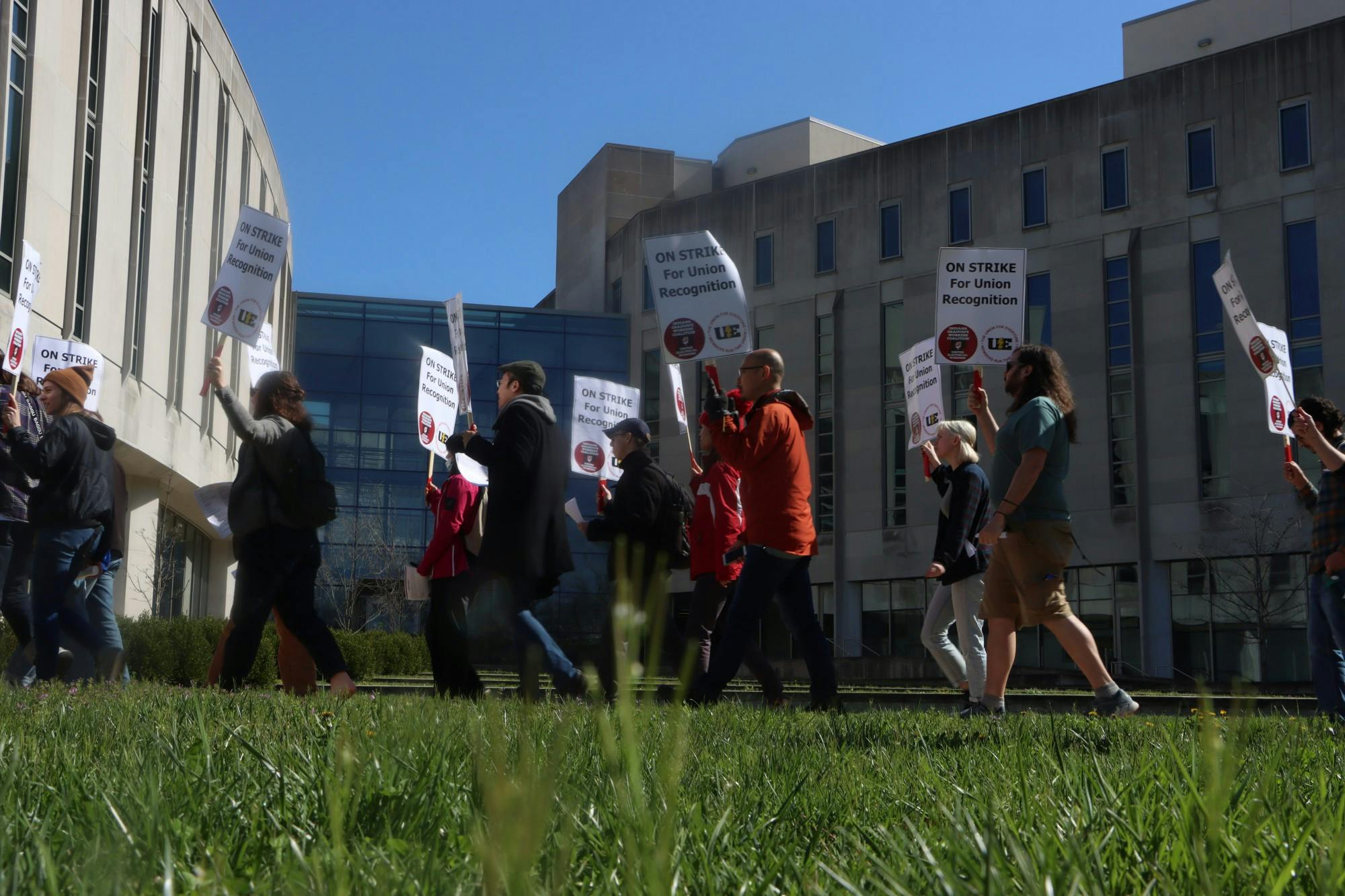
At the picket line behind the Global and International Studies Building, the picketers started singing “Bella Ciao,” a 19th-century Italian protest song.
Then they sang it again. And again. Then they sang in Chinese, Spanish and Italian again.
The group, which started with around 30 students at 10 a.m. and grew to 100 by noon, picketed for two hours before marching to Ballantine.
Multiple faculty members spoke to the picketers, including the chair of Germanic Studies Ben Robinson.
“If we get a union in southern Indiana, we’re changing the world, people,” Robinson told the group.
Annalise Caine, a graduate student in the Department of Theatre, Drama, and Contemporary Dance, did a short performance that she wrote comparing a meeting between graduate students and the administration to talking with a bad ex-boyfriend.
Related: [Community members support graduate workers at Canterbury House with soup]
Caine said it was a relationship built on trust, like an ex-boyfriend searching through your phone, and listening, as if he walked out mid-conversation.
The second time the picketers walked around the Global and International Studies Building, the group had grown large enough to break into two separate chants.
When a tour of prospective IU students walked by towards Herman B Wells Library, the demonstrators cheered and raised their “ON STRIKE for Union Recognition” signs.
“Welcome to IU!” they shouted.

At noon on any given Thursday, Ballantine Hall is bustling with students moving between classes and climbing the ten story building. This Thursday, Ballantine sat silent.
The Indiana Graduate Workers Coalition planned an undergraduate student walk-out for noon Thursday, instructing undergraduates to leave their classes in a show of solidarity for the graduate student worker strike.
The only issue? There were hardly any students in Ballantine to walk out.
With many graduate students on strike, the classrooms sat nearly empty. No associate instructors were left to lead discussion sections, teach foreign language courses or offer assistance in computer labs.
The eerie silence of the building was only interrupted by the chants of demonstrators outside. On one side of the building bicyclists ride through the streets holding picket signs and blowing noise makers. On another side of the building, protests walked in circles chanting.
“What’s disgusting? Union busting.”
“What’s outrageous? Stagnant wages.”
The rhymes echoed through the empty halls. In the moments of silence between cheers, even the smallest interactions could be heard from afar.
The conversation of two girls sitting at the bottom of the north steps floated up to the third floor. The girls were undergraduate students stopping inside Ballantine to take a break from picketing.
One held a sign reading “5 grads in a townhouse 6 ft apart because they’re not paid,” referencing a viral vine.
Both said they would have participated in the walk-out, but did not have classes to walk out of — they were already canceled due to the strike.
Three floors above them, a single student sat in a computer lab as a professor explained the strike. The lone professor’s voice reverberated through the hall.
“My experience tells me the students will win here.”
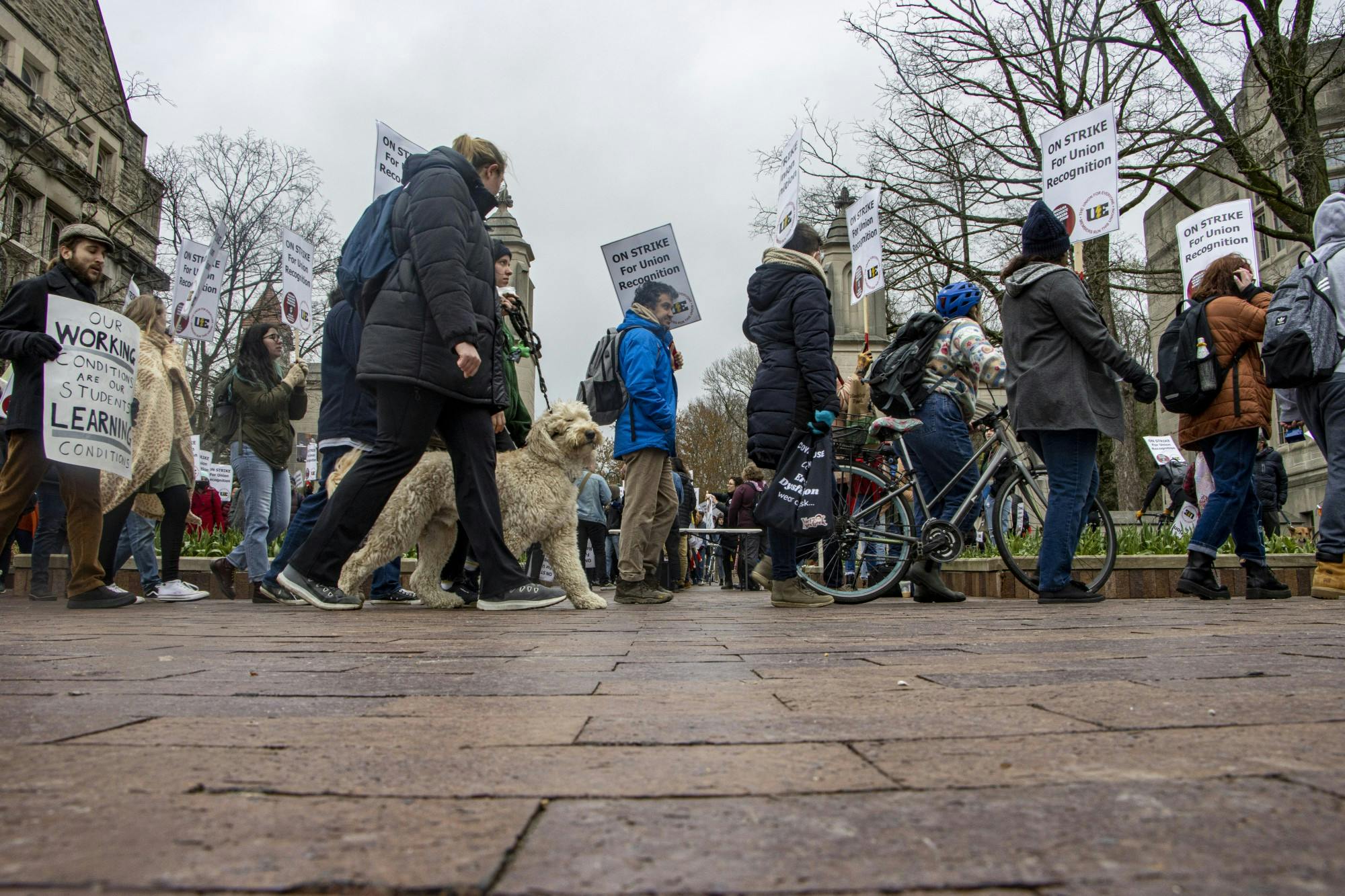
A heated chess match was underway at Sample Gates around 1 p.m. on April 18.
People walking their dogs on the brick pavement turned their heads periodically to check the status of the game.
“She’s the grandmaster,” one of the bystanders said, pointing to a student sitting by wilting flowers while moving a pawn.
To her side laid a picketing sign, one of dozens all around her.
The students sat in the middle of a crowd of more than 100 students, many of which are on their sixth day of striking in favor of the university’s recognition of the Indiana Graduate Workers Coalition-United Electrical Workers.
The students were protesting following a press conference featuring undergraduate students who spoke in favor of the university’s recognition of the union Monday. By that morning, the IGWC-UE reported that around 1,118 graduate workers had pledged to strike.
“The working conditions of the graduate workers are tied to the quality of our educational careers,” IU junior Sidd Das said during the conference about undergraduate students’ education.
As Monday was “pet day” for the graduate student strike, dogs adorned with bandanas mingled among the crowd, waiting for more attention from strangers.
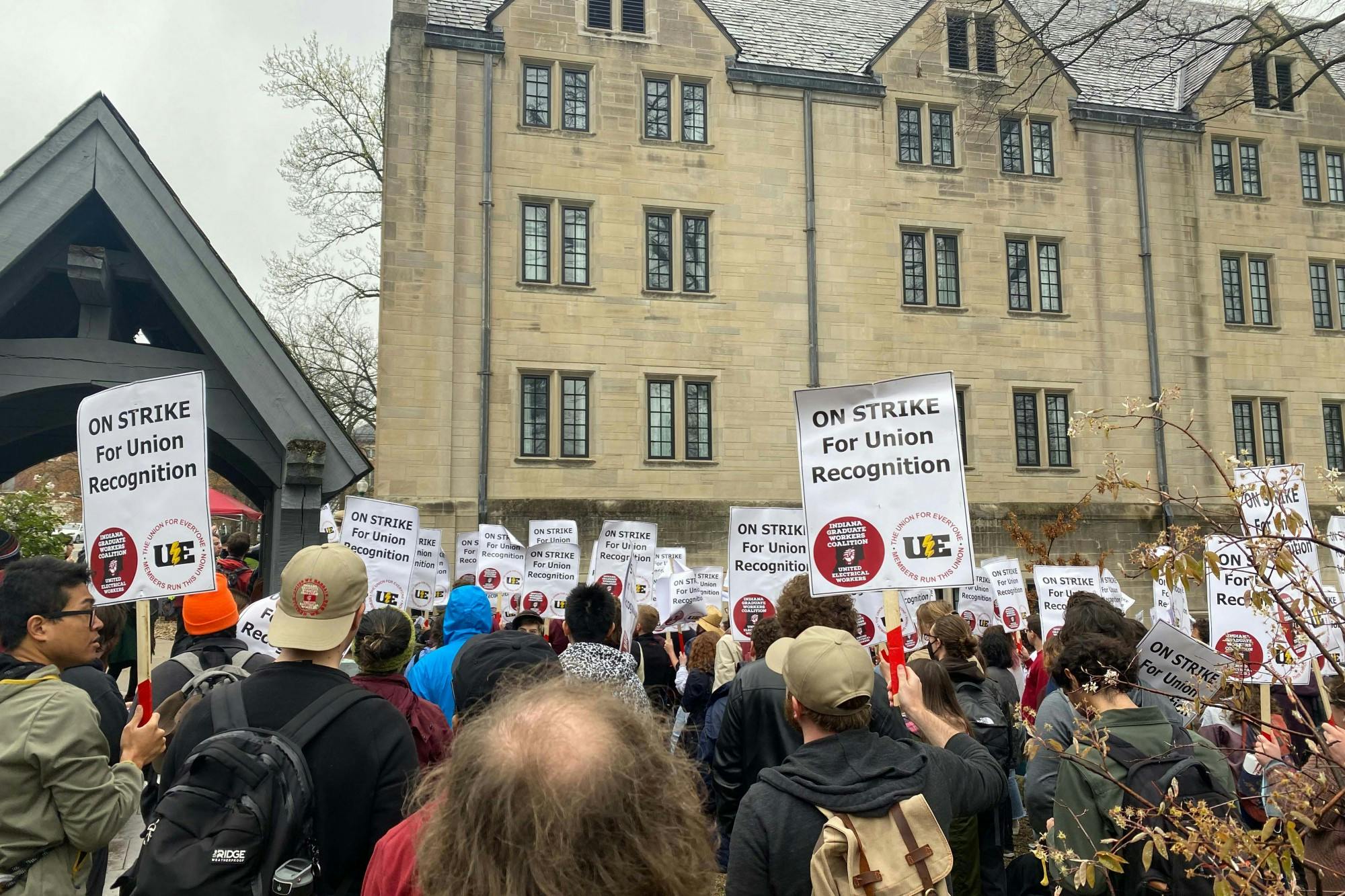
Charles Ault, a third-year graduate worker in the chemistry department, stood atop the rock structure facing a crowd around Beck Chapel. Inside the Indiana Memorial Union, department chairs and deans from across campus were attending a meeting — the topic of which is unclear. Police officers stood before a window overlooking the protestors, scanning the scene below them.
Wearing black jeans, glasses and a red shirt with elements from the periodic table spelling out “Union,” Ault spoke to the crowd with a megaphone.
“This university thrives on exploiting us by dividing us,” Ault said.
Ault asked the crowd to take a moment to look around them, to note how many people showed up from each department, from the Bloomington community and from the undergraduate community on campus.
“This is what solidarity means,” Ault said. “We will win.”
As he finished his speech, people of all ages who had clustered together outside the IMU cheered. Union recognition signs in hand and rain jackets on their backs, they joined together in unison.
Off to the side on East Kirkwood Avenue near the chapel, four non-protestors stood with IU lanyards reading “Demonstration Response and Safety Team.” They chatted silently to themselves as the protestors continued to sing louder and cheer harder.
One protestor grabbed a white paint bucket, banging on it with a drum stick to the tune of the cheers. Another person in an orange shirt danced as the protestors sang.
Later, they grabbed the microphone, engaging the protestors in a song reminiscent of the French tune “Frère Jacques.”
“Listen Whitten/ Listen Whitten/ Do you hear?/ Do you hear?/ We want to form a union/ We want to form a union/ Is that clear?/ Is that clear/”
Walking by the strike location, students and passerbyers looked upon the protestors. One woman walked by and gave a thumbs up. Another, a little farther away from the action, spoke to her friend.
“Honestly, shout out to the grad workers.”
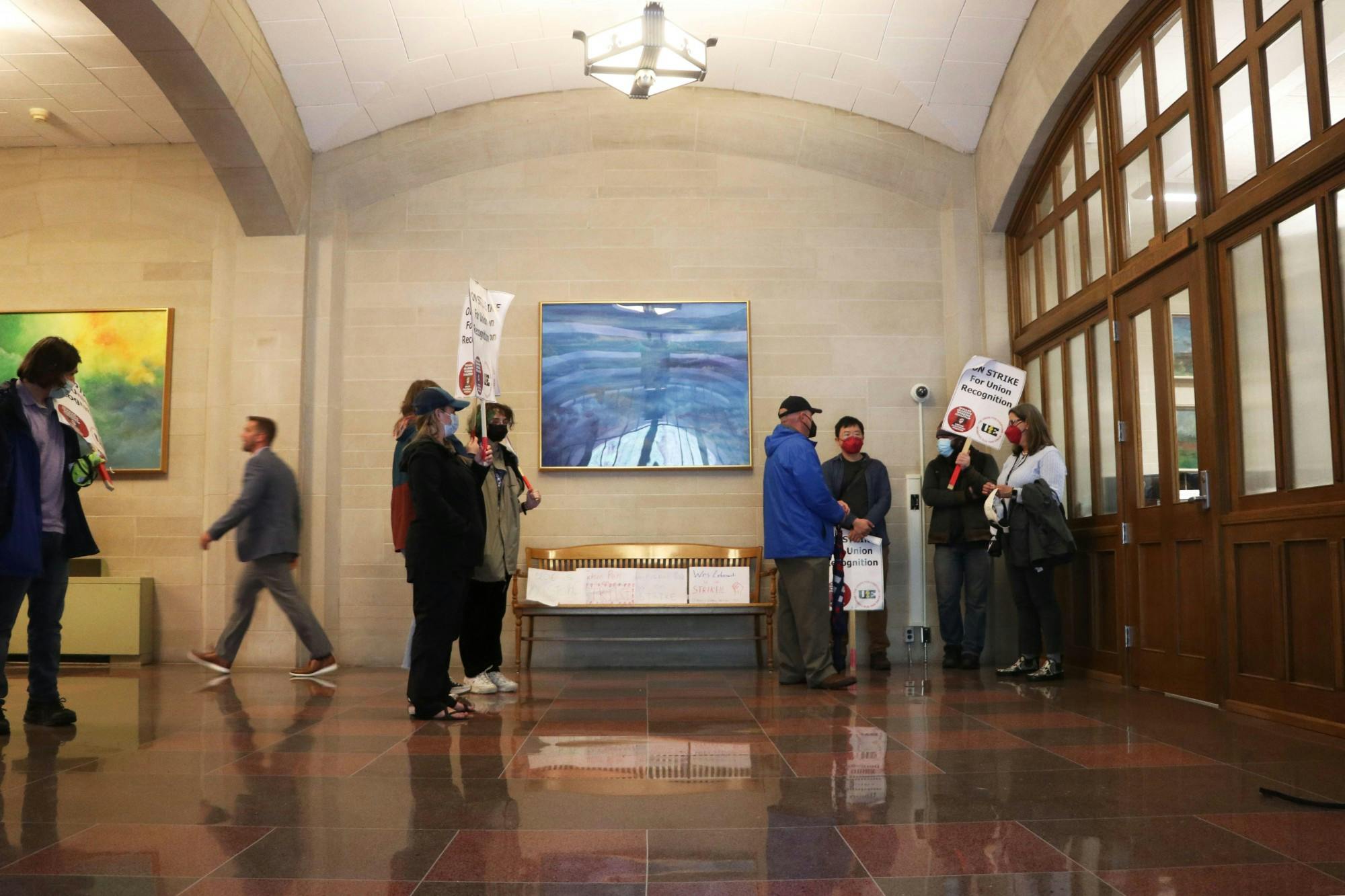
The line snaked along the edge of campus. From afar, the first noticeable feature was the sea of white from the picket signs. The end of the parade touched Sample Gates and spilled out into the grassy path. In total, there were more than 100 graduate students.
The graduate workers had planned a march at noon toward Vice Provost Eliza Pavalko’s office in Bryan Hall on April 25. They would soon be arriving at her office to demand recognition of their union.
“The event is intended to help bring IGWC-UE demands directly to the IU Administration
and indicate that graduate workers are not afraid of the various threats made against them by the university,” an April 24 press release said.
This decision came after the graduate workers had been on strike for more than a week and half. Many of them had stopped instructing and grading for their respective classes.
On the ground, a line was marching quickly toward Bryan Hall. The first few graduate workers walked up the steps and into the quiet administrative building. Slowly, the crowd grew louder as the protestors followed one another inside.
A man handed Huixin Tian a megaphone. He held it up above the crowd for Tian as she spoke into the receiver. In her hand, she gripped a sign that read “Huixin Tian is on strike.” She shook it quickly as she spoke.
“I reveal my name because I know all of the people here got my back,” Tian said.
Around Tian, many of her colleagues held up signs listing their full names. They cheered loudly in response and their volume increased until it peaked at a dull roar.
They waited for Pavalko to leave her office. The door opened and shut, but she did not appear. At one point, two members from the university’s Demonstration Response and Safety Team interrupted the crowd as they started to read lines from Pavalko’s dissertation — written decades ago. The two employees said they supported the students’ right to assemble, but they could not disrupt university business.
“The point is to disrupt!” one person screamed from the crowd in response.
The two sides went back and forth for several minutes. Little by little, some protestors started to walk out of the building into the sunshine.
Once the crowd had dwindled in size, some of the graduate workers suggested they leave.
“The real pressure is us not instructing,” one worker explained.
After a while, the crowd dwindled down to half its original size, then 20 people were left, then 10. By 12:30 p.m. only a handful of students remained. They said their strength was in numbers, so they would find another time to be heard.
At the end, only three students faced the tall wooden doors. They did not speak.. They did not look away. They were waiting with picket signs in hand for someone who would likely never come.
A stalemate continued on the first floor of Bryan Hall.

Prospective IU students filed out of the Indiana Memorial Union in the early afternoon of April 29. Chants echoed from the front gates as they slowly walked toward the north side of campus.
“Hey hey, ho ho, IU’s standards are too low.”
High school students had arrived on campus earlier that day to tour the university for IU’s “Red Carpet Day.” Parents held red folders filled with IU orientation information. As some passed by, they looked down — avoiding eye contact with the protestors. Others smiled, danced and chanted along with the workers.
“Who runs IU? We run IU.”
A crowd of approximately 60 people huddled by the gates leading up to the IMU.
Some protestors were wearing shirts including the Indiana Graduate Workers Coalition-United Electrical Workers logo and a line.
“On strike, because we care.”
Every hour, the group of graduate workers began what they referred to as “disorientation tours.” After leaving the IMU, the line of people made their way through campus, commenting on the university’s alleged budget as they walked.
The students made their way to the Metz Bicentennial Grand Carillon, stopping to inspect it briefly.
“Do you know how much it costs?” Graduate worker Annalise Cain asked the crowd.
She later answered that the monument cost the university $7 million.
“And do you wanna know how much I make?” Cain said. “A lot less than that.”
Cain said she made $15,000 a year as a graduate instructor.

